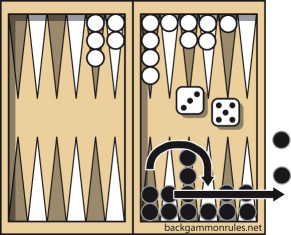End game
Removing checkers (bearing off) or playing up
All 15 checkers have to be in one's inner table. If that happens at the first part of a two-stage move, bearing off may start with the second.
Borne off checkers are placed beside the board.
If a blot is hit while bearing off it must be re-entered and moved around again before the bearing off can continue.
There is no obligation to bear off, if a player rather moves a checker closer to the exit. This so called playing up is mandatory, if a point higher than the roll is occupied.
If a rolled number corresponds to an occupied point
- A checker can be removed from the corresponding point (for example: 2 and 4) or else
- Moved inside the inner table to place it on a lower point (for example: roll-3, the checker on point 6 is played up to 3).
If a rolled number corresponds to an unoccupied point
- If there is no checker on a higher point, bear off the checkers on the next lower number.
- If a checker is on a higher point, bearing off is not allowed. Move the checker towards the exit (play up).
- Roll the dice and play up and/or bear off
The winner is ...
The first player to bear off all his checkers.
Counts
| State of loser's checkers |
Kind of win |
Value |
| The loser has removed at least one checker |
Simple win |
Original stakes |
| The loser has not removed any checker |
Gammon |
Double stakes |
| The loser has not removed any checker from the board and has one or more checkers in the winner's inner table or on the bar |
Backgammon |
Triple stakes |
Tactics / strategies
- Protect your own checkers: avoid blots (only one of your checkers on a point), make points (two or more of your checkers on one point) and build blocks (consecutive made points).
- Make points and blocks to hinder your opponent's progress:
He cannot land on your points which might hinder his moves altogether. In your inner table, points and blocks serve well to make re-entering checkers difficult.
- Hit your opponent's checkers, considering your own risk.
- It's a race: the faster one has the advantage.
- The holding game: If you are not ahead, maintain control of a point on the opponent's side of the board (anchor) in the hope to hit a blot and roll large doubles for a fast escape.
- The back game: When hopelessly behind, opt for building two or more anchors in the opponent's inner table plus a wall of checkers (prime) to obstruct the opposing checkers behind it.
- Blitz: Cover your entire inner table as quickly as possible to render the opponent's re-entering and escaping very difficult.
Next -> Doubling and Gambling
|




